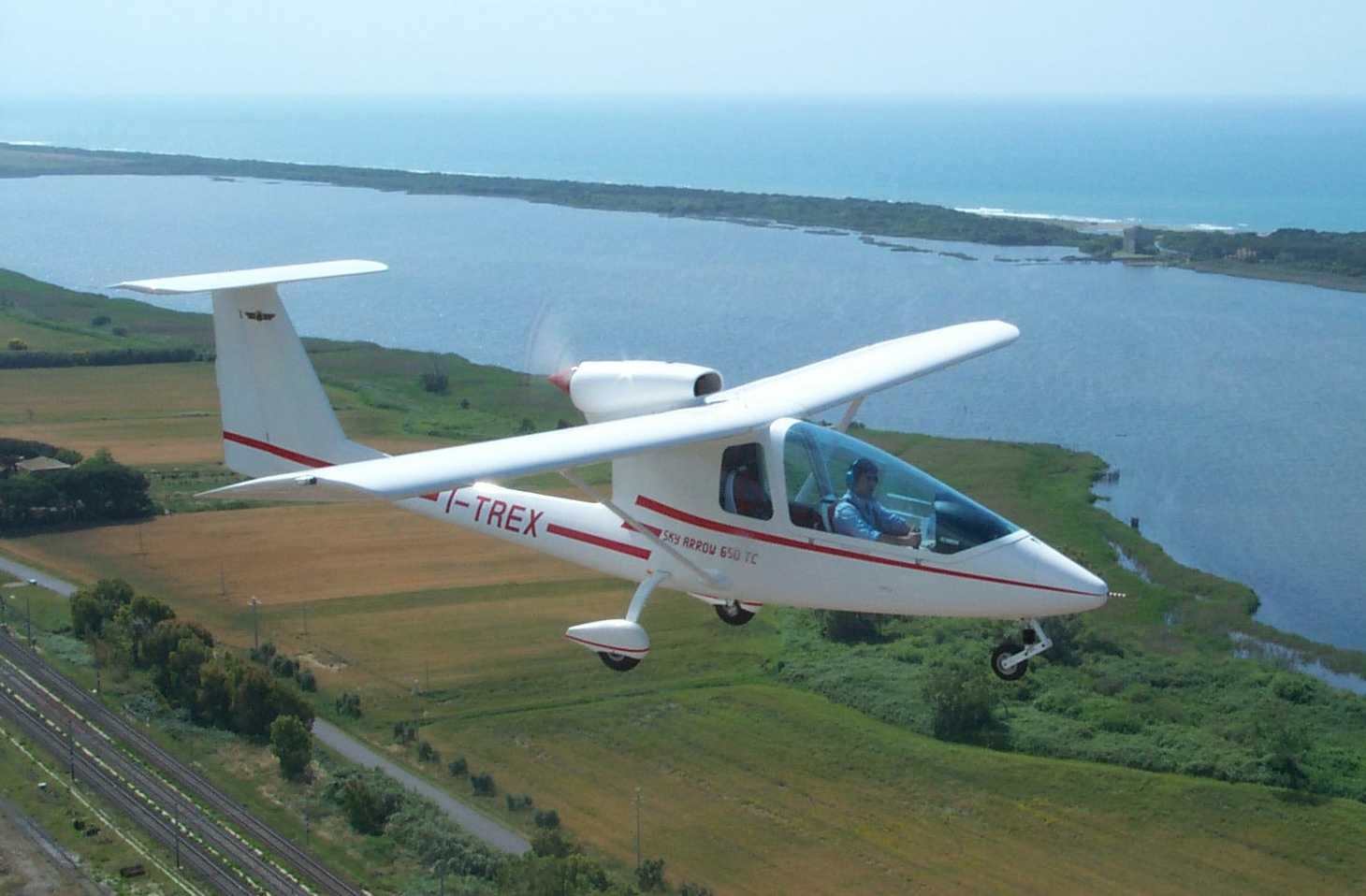Certification
The
Sky Arrow 650 TCN has been type certified in March 1996 in Italy and in
October 1997 in U.S.A. The TCN version is in compliance with FAR 23,
Amendment 42 requirements, as listed in FAA Advisory Circular AC-23.11
dated December 02, 1992. The engine is certified to FAR 33 and the
propeller to FAR 35. Noise has been tested in accordance with FAR 36,
Appendix G, and ICAO Annex 16, Chapter 10.
The Sky Arrow
650 TCN is type certified for day and night VFR in the U.S.A. and those
countries that recognize Advisory Circular AC-23.11. They are used for
recreation, sport, training and aerial reconnaissance. In the UK, they are
also certified in the Transport Category (passenger). The aircraft, due to
its tandem configuration, is also usable for military initial training.
For this reason pneumatic gyroscopic instruments, with the relevant engine
drive and pump, are part of the standard configuration. Due to the
possibility to be used in night operations, navigation, strobe, landing,
cabin and map lights are installed, as well as an additional alternator.
Fuselage
The
fuselage is almost entirely made of carbon fiber sandwich in an epoxy
resin matrix. Kevlar is used in some areas, such as the cabin, where added
strength is requested for crash worthiness. The two fuselage halves are
bonded together along the vertical plane.
Internally, the
fuselage includes six minor bulkheads and two main ones. One of these
bulkheads supports the main landing gear and the engine. The aircraft may
be controlled from either seat.
The front rudder
pedals are adjustable. A baggage compartment is located behind the back
seat, and small bags can be stowed underneath it. The fuel tank is located
in the fuselage, behind this seat.
The one-piece,
glider-style canopy provides exceptional outside visibility. The engine
and fuel tank attachments have been statically tested in crash landing
simulations up to 18 g’s.
Wings
The airfoil is
a Gottinga 398 modified for better handling at low speeds. Each wing is
attached to the fuselage with 3 bolts (two at the root rib and one at the
wing strut) secured by castle nuts and easily removable safety pins.
The wing and the
control surfaces are made of carbon fiber. The two wing spars are of “C”
section. Wing flaps are actuated electrically and can be positioned at 0,
10, 20 and 30 degrees. The ailerons are actuated via aluminum control rods
and bellcranks.
Landing Gear
The
tricycle landing gear is fixed. The main landing gear leaf springs are
made of fiberglass roving. The nose gear strut is steel and carbon fiber.
It features a “donut” type shock absorber and a shimmy damper. The nose
gear is free castoring. Steering is provided by a combination of
hand-operated differential braking of the main wheels (low speed) and
rudder actuation (high speed).
Powerplant
The
engine is a Rotax 912F, certified to FAR 33, with a maximum power of 81 HP
at 5,800 rpm. The engine is a horizontally opposed, 4 cylinder, 4 stroke
type. It features liquid cooled cylinder heads and air cooled cylinders,
dual ignition, dry sump lubrication, dual carburetors and a propeller
drive reduction gear box with clutch. The engine features one internal and
one external alternator. The engine mount is made of aircraft steel
tubing. The propeller is 2 blade, fixed pitch, certified to FAR 35.
Empennage
The rudder
is made of fiberglass sandwich with a termanto core. It is actuated by
dual cables and aluminum rod via a bellcrank. Both the horizontal
stabilizer and elevator are in carbon fiber sandwich, in an epoxy resin
matrix, with an electrical actuated trim tab. Aluminum control rods
actuate the elevator.
Electrical
Electric
power is provided by a twelve-volt battery located in the nose of the
airplane and is supplied to the electrical system via a bus. An external
40-amp alternator, driven by a belt connected to the propeller shaft,
provides power to the battery and the main electrical bus. A second 18-amp
internal alternator provides power to the engine ignition system and also
serves as a source of emergency power in the vent of a malfunction of the
primary alternator. Circuit
protection is provided by circuit breakers located on the instrument
panel. The instrument panel is prepared to accept various instruments in
addition to the standard ones.



.jpg)
.jpg)